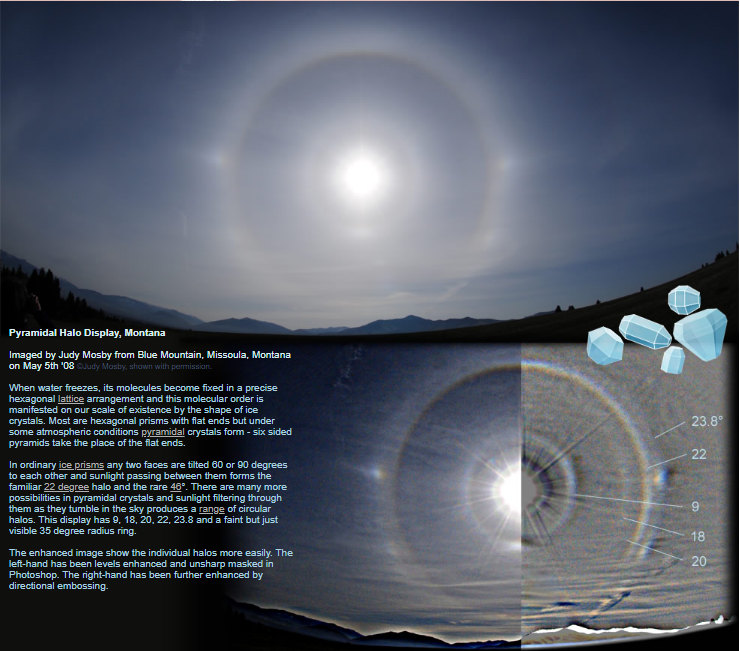Montana Pyramids
Montana Pyramids: A Mesmerizing Display of Atmospheric Optics
Atmospheric optics never ceases to amaze us with its stunning displays of natural phenomena. One such mesmerizing spectacle is the pyramidal halo display observed in Montana. This captivating phenomenon occurs when atmospheric conditions are just right, resulting in the formation of pyramidal ice crystals instead of the usual hexagonal prisms.
When water freezes, its molecules arrange themselves in a hexagonal lattice structure. On a larger scale, this molecular order is reflected in the shape of ice crystals. While most ice crystals take the form of hexagonal prisms with flat ends, under specific atmospheric conditions, pyramidal crystals emerge, replacing the flat ends with six-sided pyramids.
In ordinary ice prisms, sunlight passing through any two faces tilted at 60 or 90 degrees to each other produces the familiar 22-degree halo and occasionally the rare 46-degree halo. However, pyramidal crystals offer a much wider range of possibilities. As sunlight filters through these tumbling crystals in the sky, it gives rise to a captivating array of circular halos.
The pyramidal halo display witnessed in Montana showcases a unique combination of halos. The enhanced image of this phenomenon reveals individual halos more clearly. By employing image enhancement techniques such as levels enhancement and unsharp masking in Photoshop, the left-hand side of the image brings out the distinct halos. On the other hand, the right-hand side has undergone further enhancement through directional embossing, providing a more detailed view.
Let's delve into the fascinating array of halos observed in the Montana pyramidal halo display:
-
The 9-degree halo: This halo forms at a radius of 9 degrees from the sun and appears as a faint ring encircling it.
-
The 18-degree halo: Located at a radius of 18 degrees from the sun, this halo is often brighter and more prominent than the 9-degree halo.
-
The 20-degree halo: At a radius of 20 degrees, this halo adds to the captivating display with its distinct ring shape.
-
The 22-degree halo: A well-known and frequently observed halo, it forms at a radius of 22 degrees from the sun. This halo is particularly striking due to its circular shape.
-
The 23.8-degree halo: This halo, located at a radius of 23.8 degrees from the sun, contributes to the overall spectacle with its unique appearance.
-
The faint 35-degree halo: Though barely visible, this halo completes the ensemble of halos observed in the pyramidal halo display. It forms at a radius of 35 degrees from the sun.
The Montana pyramidal halo display showcases the astonishing complexity and beauty that can arise from different crystal formations within ice prisms. As sunlight interacts with these pyramidal crystals, it scatters and refracts, giving rise to a symphony of halos that captivate observers lucky enough to witness this atmospheric phenomenon.
In conclusion, the pyramidal halo display observed in Montana is a testament to the intricacies of atmospheric optics. By examining the unique formation of pyramidal ice crystals, we gain insight into the diverse range of circular halos that can be produced under specific atmospheric conditions. The enhanced image of this phenomenon allows us to appreciate the individual halos in greater detail, highlighting the awe-inspiring beauty of nature's optical displays.

Pyramidal Halo Display, Montana
Imaged by Judy Mosby from Blue Mountain, Missoula, Montana on May 5th '08 ©Judy Mosby, shown with permission.
When water freezes, its molecules become fixed in a precise hexagonal lattice arrangement and this molecular order is manifested on our scale of existence by the shape of ice crystals. Most are hexagonal prisms with flat ends but under some atmospheric conditions pyramidal crystals form - six sided pyramids take the place of the flat ends.
In ordinary ice prisms any two faces are tilted 60 or 90 degrees to each other and sunlight passing between them forms the familiar 22 degree halo and the rare 46°. There are many more possibilities in pyramidal crystals and sunlight filtering through them as they tumble in the sky produces a range of circular halos. This display has 9, 18, 20, 22, 23.8 and a faint but just visible 35 degree radius ring.
The enhanced image show the individual halos more easily. The left-hand has been levels enhanced and unsharp masked in Photoshop. The right-hand has been further enhanced by directional embossing.
Note: this article has been automatically converted from the old site and may not appear as intended. You can find the original article here.
Reference Atmospheric Optics
If you use any of the definitions, information, or data presented on Atmospheric Optics, please copy the link or reference below to properly credit us as the reference source. Thank you!
-
<a href="https://atoptics.co.uk/blog/montana-pyramids/">Montana Pyramids</a>
-
"Montana Pyramids". Atmospheric Optics. Accessed on April 20, 2024. https://atoptics.co.uk/blog/montana-pyramids/.
-
"Montana Pyramids". Atmospheric Optics, https://atoptics.co.uk/blog/montana-pyramids/. Accessed 20 April, 2024
-
Montana Pyramids. Atmospheric Optics. Retrieved from https://atoptics.co.uk/blog/montana-pyramids/.